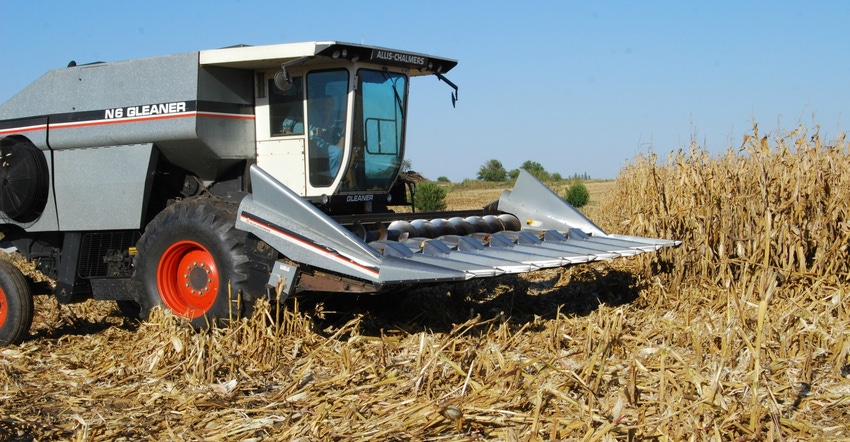
After rain delays during the first half of October, a week of mostly dry weather allowed Iowa farmers to get back into fields with their combines last week. Iowa had a 12% increase in corn harvest progress during the week ending Oct. 21, according to USDA’s weekly statewide survey. The 2018 Iowa corn crop was 29% harvested as of Oct. 21, compared with only 17% a week earlier and a 38% average for the past five years.
Soybean harvest in Iowa is still lagging at only 37% harvested. Iowa State University grain quality specialist Charles Hurburgh is urging farmers to try to get beans harvested as soon as possible, as some are having quality problems with mold developing on pods on plants still standing in fields. Soybeans with less than 15% moisture can be dried with bin fans.
Hurburgh cautions farmers to pay attention to temperature when drying soybeans. Compared to corn, beans are fragile and can be damaged by air that’s too hot or too dry and can also be damaged from rough handling.
While many farmers across Iowa were able to get back into their fields this past week, statewide Iowa remains well behind the five-year average for harvest progress. “The 29% of corn harvested is four days behind average and the 37% of beans harvested puts us 12 days behind,” notes Mike Naig, Iowa secretary of agriculture. “However, our farmers can make tremendous progress in a week if conditions allow. Farmers harvested 65% of soybeans in a single week back in 2013 and 30% of corn in a week in both 1993 and 2013. So, hopefully the drier weather will stay in place and farmers can start to catch up.”
The Iowa Farm Bureau and Decision Innovation Solutions have analyzed Iowa Crop Progress & Condition Reports going back to 1990 looking at the largest week of corn and soybean harvest each year. Additional information about their analysis can be found here.
The complete weekly Iowa Crop Progress and Weather Report is at iowaagriculture.gov and nass.usda.gov/ia.
Crop report
Sunshine and a break from substantial precipitation got Iowa farmers back in the fields with 4.4 days suitable for fieldwork during the week ending Oct. 21, according to USDA’s National Ag Statistics Service. Activities for the week included harvesting corn and soybeans, baling stalks and planting cover crops.
Topsoil moisture rated zero percent very short, zero percent short, 65% adequate and 35% surplus. Subsoil moisture levels rated zero percent very short, 2% short, 61% adequate and 37% surplus.
The survey showed as of Oct. 21, 29% of Iowa’s corn for grain crop has been harvested, 3 days ahead of last year but four days behind the five-year average. Farmers in southeast Iowa have neared the halfway point of corn harvest while farmers in the northeast have not yet harvested one-fifth of their corn. Moisture content of field corn being harvested was at 19% for a statewide average last week. Corn condition rated 68% good-to-excellent.
Soybean harvest was 37% complete, 12 days behind the average. This is the smallest percentage of the soybean crop harvested by Oct. 21 since 1985. Soybean condition rated 65% good-to-excellent.
Pasture conditions rated 55% good-to-excellent. Pastures have responded well to recent precipitation and cool temperatures. Cattle lots are still muddy but improving.
Weather summary
According to Justin Glisan, IDALS climatologist, after an extremely wet start to October, abnormally dry conditions returned to Iowa during the week ending Oct. 21. Statewide weekly precipitation deficits ranged from 0.20 to 0.70 inch. Northern Iowa observed the wettest conditions; Mason City (Cerro Gordo County) reported the week’s highest total accumulation of 0.61 inch. Unseasonably cool weather continued with average temperatures five to 10 degrees below average.
On Oct. 15, the remains of a cold front moved out of southeast Iowa. Burlington (Des Moines County) reported 0.48 inch of rain. Oct. 16 through early night on Oct. 18 was dry statewide with average highs in the middle to upper 50s in the eastern third of the state and lower to middle 60s across the rest of Iowa. Multiple locations in northwest Iowa observed highs above 70 degrees on Oct. 17, up to 10 degrees above normal.
A cold front with rain showers moved into Iowa the night of Oct. 18 and lingered through late morning Oct. 19. Heaviest rainfall occurred in northern Iowa; St. Ansgar (Mitchell County) recorded 0.50 inches. Much of Iowa’s southern two-thirds received between a trace and a tenth of an inch. Cloud cover moved out of Iowa later in the day Oct. 19 into Oct. 20. A second cold front sped through Iowa on Saturday bringing cooler air and windy conditions statewide.
Stations in eastern Iowa on Oct. 20 observed sustained winds between 20 to 30 mph with gusts in the 40 to 50 mph range in the late afternoon, which caused some corn to lodge. Oct. 21 was pleasant as high pressure dominated the region. Skies were generally clear with unseasonable coolness. Red Oak (Montgomery County) and Shenandoah (Page County) reported the week’s high of 73 degrees on Oct. 19, 9 degrees above average. The town of Stanley (Buchanan County) observed the week’s low temperature of 18 degrees on Oct. 21, a cool 17 degrees below average.
About the Author(s)
You May Also Like




